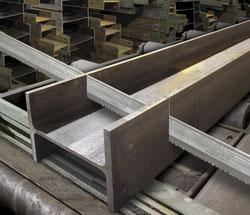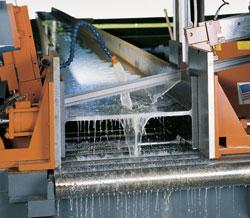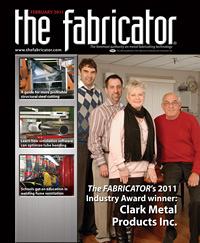Director, Technical Sales
- FMA
- The Fabricator
- FABTECH
- Canadian Metalworking
Categories
- Additive Manufacturing
- Aluminum Welding
- Arc Welding
- Assembly and Joining
- Automation and Robotics
- Bending and Forming
- Consumables
- Cutting and Weld Prep
- Electric Vehicles
- En Español
- Finishing
- Hydroforming
- Laser Cutting
- Laser Welding
- Machining
- Manufacturing Software
- Materials Handling
- Metals/Materials
- Oxyfuel Cutting
- Plasma Cutting
- Power Tools
- Punching and Other Holemaking
- Roll Forming
- Safety
- Sawing
- Shearing
- Shop Management
- Testing and Measuring
- Tube and Pipe Fabrication
- Tube and Pipe Production
- Waterjet Cutting
Industry Directory
Webcasts
Podcasts
FAB 40
Advertise
Subscribe
Account Login
Search
Transforming structural cutting challenges into profit
Proper procedures and maintenance can increase bottom line
- By Glenn Tatro
- January 27, 2011
- Article
- Sawing

Figure 1: The difficult job of cutting structural materials to length can be simplified by choosing the correct blade for the job, running it properly, and maintaining both the blade and machine.
Structural steel is available in many grades, shapes, and sizes. Carbon and alloy steels can be found on the market as I-beams, H-beams, square tubing, pipe, channel or angle iron, rail, and plate. High-strength steels are vital components in the transportation industry, machine building, and construction projects.
While having so many material options is beneficial to the industrial world, it can pose a serious challenge to those who have to cut the structural steel to length (see Figure 1). Although difficult, these cutting challenges are not insurmountable and can be made much easier with the correct blade, proper machine operation, and thorough maintenance of the blade and machine. Following a few simple tips will increase blade life, provide cleaner and smoother cuts, and ultimately lower the cost per cut.
Tooth Selection
Tooth selection is a critical consideration when cutting any type of steel with a band saw blade.
For structural steels, the tooth selection should focus on the wall thickness. Thinner-walled structural steel requires a finer tooth blade characterized by more teeth per inch (5/8T or finer). A shape like an I-beam may have a thicker wall and therefore may require a coarser-pitched blade (2/3T or similar).
Most saw blade manufacturers provide charts to assist in choosing the proper tooth configuration, which leads to better chip removal and longer blade life. Software programs also are available from blade manufacturers to help in choosing the right tooth form, as well as the correct product, band speed, feed rate, and number of pieces to cut at one time.
Blade Break-in
Using the correct break-in procedure on a new saw blade can increase blade life by up to 50 percent. A precision-milled or -ground saw blade typically has very sharp teeth; if the teeth are not gradually honed to a radius on the tip, they can break off easily on first contact with the material.
The sharpened teeth are similar to a sharpened pencil: The very sharp lead point will break off immediately if pushed too hard. However, if the force used on the pencil is increased gradually, the lead forms a rounded tip that eventually can accept higher pressure and last longer. When properly broken in, the teeth on a saw blade form a radius and prevent premature fracturing.
To break in a blade properly, the saw operator first selects the proper band speed for the material to be cut. Then he needs to reduce the feed rate to below the normal rate. The reduction in rate varies with the grade of metal and can range from 20 to 50 percent of normal. Softer grades require a larger feed rate reduction than harder materials.
The first cut is done at the reduced rate. The operator needs to ensure that the teeth are forming a chip. During the first cut, the operator then increases the feed rate slightly once the blade fully enters the workpiece. With each additional cut, the feed rate is increased until the desired cutting rate is reached.
Band Saw Speed
Proper band saw speed is crucial when cutting structural steel. For example, A36 carbon steel material—the most widely used structural—typically is cut at about 250 FPM, but this can vary depending on the wall thickness. With this softer steel, a higher band speed is required to get the tooth in and out of the cut quickly. Otherwise, the tooth can drag and pull a thick chip, which puts additional stress on the tooth and leads to tooth or blade breakage.
A common mistake is to slow the band speed down if teeth start to strip off; in most cases, however, this amplifies the problem. The optimal band speeds on softer metals such as carbon steel and aluminum usually are much higher than on harder steels such as nickel alloy and mold steels.
Bundle Loading
It’s important to place the metal in the vise properly so that the blade cuts a consistent cross section of material at a consistent feed rate all the way through the cut.
Some saw blade manufacturers use a software program to determine the optimal way to bundle or stack the steel. Bundling has a direct impact on tooth selection. As a rule, the tooth pitch used on bundles may be slightly coarser than the pitch used on a single piece of steel.
Coolants
Some saws use a flood application that directs large amounts of coolant toward the teeth (see Figure 2), while others use a droplet-type lubricant system to minimize the amount of fluid used in the operation.
For flood applications, it’s imperative to maintain the proper mix ratio for the fluid as recommended by the manufacturer. A refractometer can help maintain the proper water-to-fluid ratio. Using the right concentration allows the fluid to provide optimal lubrication and reduce frictional heat between the blade and workpiece. Fluids also provide cooling and aid in chip formation and evacuation.
Maintenance
A preventive maintenance program that addresses machine condition and calibration can reduce the operating costs of band saws. If resources do not allow for an internal maintenance program, it is important to find a saw blade manufacturer that provides the services of a technical service representative.
Proper maintenance includes checking the condition and alignment of band saw guides, checking blade tension and blade tracking, and cleaning the machine sump twice yearly. When the saw is performing at its best, the saw and saw blade are working in unison and reduce the risk of blade breakage, ultimately increasing productivity and profit.
Operators who are trained properly in running and maintaining the machine and blades according to the manufacturer’s recommendations will help improve blade life, reduce blade changes, and lower operating costs overall—turning cutting challenges into successes.
About the Author
Related Companies
subscribe now

The Fabricator is North America's leading magazine for the metal forming and fabricating industry. The magazine delivers the news, technical articles, and case histories that enable fabricators to do their jobs more efficiently. The Fabricator has served the industry since 1970.
start your free subscription- Stay connected from anywhere

Easily access valuable industry resources now with full access to the digital edition of The Fabricator.

Easily access valuable industry resources now with full access to the digital edition of The Welder.

Easily access valuable industry resources now with full access to the digital edition of The Tube and Pipe Journal.
- Podcasting
- Podcast:
- The Fabricator Podcast
- Published:
- 04/16/2024
- Running Time:
- 63:29
In this episode of The Fabricator Podcast, Caleb Chamberlain, co-founder and CEO of OSH Cut, discusses his company’s...
- Industry Events
16th Annual Safety Conference
- April 30 - May 1, 2024
- Elgin,
Pipe and Tube Conference
- May 21 - 22, 2024
- Omaha, NE
World-Class Roll Forming Workshop
- June 5 - 6, 2024
- Louisville, KY
Advanced Laser Application Workshop
- June 25 - 27, 2024
- Novi, MI
































